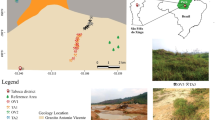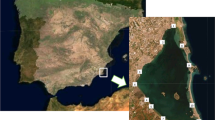Abstract
The distribution of selected heavy metals, including some radionuclides, metalloids and non-metals was determined in stream sediments in a region influenced by abandoned copper mining and ore processing activities. A considerable amount of the ore processing waste with a very complex composition and highly elevated concentrations of zinc, sulfur, lead, copper, arsenic, and a lot of other elements in the range between 100 and 1,000 mg/kg (Sb, Mn, Ni, Cr, Cd, Hg, and Ag) was piled up on mine dumps. The dispersion of the pollutants originating from this source and their environmental impact were investigated. Both, sediments and original waste material were studied to indicate the pathways and the mobilization behavior of different pollutants. For this purpose, the process of the elution of pollutants by application of different fractionation schemes was studied. The capabilities of different analytical techniques are shown for the analysis of solid samples (X-ray fluorescence spectrometry, Gamma-spectrometry) and liquid ones (ICP-atomic emission spectrometry, ICP-mass spectrometry and different techniques of atomic absorption). Additionally, the coupling of ion chromatography and ICP-MS detection was used to study the distribution of arsenic species in the sediment cores of a lake which acts as a natural sink for the region.











Similar content being viewed by others
References
Becker A, Klöck W, Friese K, Schreck P, Treutler HC, Spettel B, Duff MC (2001) Lake Suesser See as a natural sink for heavy metals from copper mining. J Geochem Explor 74:205–217
Brigth DA, Dodd M, Reimer KJ (1996) Arsenic in subArctic lakes influenced by gold mine effluent: the occurrence of organoarsenicals and ‘hidden’ arsenic. Sci Total Environ 180:165–182
Daus B, Mattusch J, Wennrich R, Weiss H (2002) Investigation on stability and preservation of arsenic species in iron rich water samples. Talanta 58:57–65
Davidson CMM, Duncan AL, Littlejohn D, Ure AM, Garden LM (1998) A critical evaluation of the three-stage BCR sequential extraction procedure to assess the potential mobility and toxicity of heavy metals in industrially-contaminated land. Anal Chim Acta 363:45–55
Durham RW, Joshi SR (1980) Recent sedimentation rates, 210Pb fluxes and particle settling velocities in Lake Huron, Laurentian Great Lakes. Chem Geol 31:53–66
Fedotov PS, Zavarzina AG, Spivakov BYa, Wennrich R, Mattusch J, de Cunhal-Titze KP, Demin VV (2002) Accelerated fractionation of heavy metals in contaminated soils and sediments using rotating coiled columns. J Environ Monit 4:318–324
German Standards Procedure DIN 38414 part 4 (1984) Determination of the leachability by water; German standards methods for the estimation of water, wastewater and sludge: sludge and sediments (Group S). Fachgruppe Wasserchemie in der GDCh, Normausschuss Wasserwesen im DIN (eds), VCH, Weinheim
German Standards Procedure DIN 32645 (1994) Chemical analysis; decision limit, detection limit and determination limit; estimation in case of repeatability, terms, methods, evaluation. Beuth Verlag, Berlin
German Standard Procedure DIN ISO 11466 (1997) Soil quality – extraction of trace elements soluble in aqua regia. Beuth Verlag, Berlin
Hammer J, Junge F, Rösler HJ, Niese S, Gleisberg B, Stiehl G (1990) Element and isotope geochemical investigation of the Kupferschiefer in the vicinity of “Rote Fäule” indicating copper mineralization (Sangerhausen Basin, G.D.R.). Chem Geol 85:345–360
Harrington JM, Fendorf SE, Rosenzweig RF (1998) Biotic generation of arsenic(III) in metal(loid)-contaminated freshwater lake sediments. Environ Sci Technol 32:2425–2430
Kneebone PE, O’Day PA, Jones N, Hering JG (2002) Deposition and fate of arsenic in iron- and arsenic-enriched reservoir sediments. Environ Sci Technol 36:381–386
Koch I, Feldmann J, Wang L, Andrewes P, Reimer KJ, Cullen WR (1999) Arsenic in the Meager Creek hot springs environment, British Columbia, Canada. Sci Total Environ 236:101–117
Kuehnelt D, Goessler W, Irgolic KJ (1997) Arsenic compounds in terrestrial organisms I: Collybia maculata, Collybia butyracea and Amanita muscaria from arsenic smelter sites in Austria. Appl Organom Chem 11:289–296
Marques MJ, Martinez-Conde E, Rovira JV, Ordonez S (2001) Heavy metals pollution of aquatic ecosystems in the vicinity of a recently closed underground lead-zinc mine (Basque Country, Spain). Environ Geol 40:1125–1137
Matheis G, Jahn S, Marquardt R, Schreck P (1999) Mobilization of heavy metals in mining and smelting heaps. Kupferschiefer district, Mansfeld, Germany. Chron Rech Min 534:3–12
Mattusch J, Wennrich R (1998) Determination of anionic, neutral, and cationic species of arsenic by ion chromatography with ICPMS detection in environmental samples. Anal Chem 70:3649–3655
Mattusch J, Wennrich R, Schmidt AC, Reisser WM (2000) Determination of arsenic species in water, soils and plants. Fresen J Anal Chem 366:200–203
May TW, Wiedmeyer RH, Gober J, Larson S (2001) Influence of mining-related activities on concentrations of metals in water and sediment from streams of the Black Hills, South Dakota. Arch Environ Contam Toxicol 40:1–9
Pueyo M, Rauret G, Luck D, Yli-Halla M, Quevauviller P, Lopez-Sanchez JF (2001) Certification of the extractable contents of Cd, Cr, Cu, Ni, Pb and Zn in freshwater sediment following a collaboratively tested and optimized three-step sequential extraction procedure. J Environ Monit 3:243–250
Quevauviller P (1998) Operationally defined extraction procedures for soil and sediment analysis I. Standardization. TrAC Trends Anal Chem 17:89–298
Robbins JA, Edgington DN (1975) Determination of recent sedimentation rates in Lake Michigan using 210Pb and 137Cs. Geochim Cosmochim Acta 39:285–304
Rösner U (1998) Effects of historical mining activities on surface water and groundwater—an example from northwest Arizona. Environ Geol 33:224–230
Schäfer J, Blanc G (2002) Relationship between ore deposits in river catchments and geochemistry of suspended particulate matter from six rivers in southwest France. Sci Total Environ 298:103–118
Schoer J, Förstner U (1987) Abschätzung der Langzeitbelastung von Grundwasser durch die Ablagerung metallischer Feststoffe. Vom Wasser 69:23–32
Schreck P (1997) Environmental impact of uncontrolled waste disposal in mining and industrial areas in Central Germany. Environ Geol 35:66–72
Schubert M, Morgenstern P,Wennrich R, Freyer K, Weiss H (2003) The weathering behavior of heavy metals in ore processing residues (Mansfeld Region, Germany). Mine Water Environ 22:2–6
Singh SP, Ma LQ, Tack FMG, Verloo MG (2000) Trace metal leachability of land-disposed dredged sediments. J Environ Qual 29:1124–1132
Shukla BS (1993) Watershed, river and lake modeling through environmental radioactivity. Environmental Research and Publications, Hamilton, Ontario, Canada, 227 pp
Templeton DM, Ariese F, Cornelis R, Daniesson LG, Muntau H, van Leewen HP, Lobinski R (2000) Guidelines for terms related to chemical speciation and fractionation of trace elements. Definitions, structural aspects, and methodological approaches (IUPAC Recommendations 2000). Pure Appl Chem 72:1453–1470
Tessier A, Campbell PGJ, Bisson M (1979) Sequential extraction procedure for the speciation of particulate trace metals. Anal Chem 51:844–851
Weiss H, Morency M, Freyer K, Bourne J, Fontaine D, Ghaleb B, Mineau R, Möder M, Morgenstern P, Popp P, Preda M, Treutler HC, Wennrich R (1997) Physical and chemical characterization of a complexly contaminated scrubber dust -- a by-product of copper smelting in Sachsen-Anhalt, Germany. Sci Total Environ 203:65–78
Wennrich R, Mattusch J, Staerk HJ, Schlegel D, Morgenstern P, Fankhänel U (1997) Determination of arsenic species in water samples of a tin ore tailings. Vom Wasser 88:1–12
Wenzel WW, Kirchbaumer N, Prohaska T, Stingeder G, Lombi E, Adriano DC (2001) Arsenic fractionation in soils using an improved sequential extraction procedure. Anal Chim Acta 436:309–323
Williams M (2001) Arsenic in mine waters: an international study. Environ Geol 40:267–278
Wong HKT, Gautier A, Nriagu JO (1999) Dispersion and toxicity of metals from abandoned gold mine tailings at Goldenville, Nova Scotia, Canada. Sci Total Environ 228:35–47
Author information
Authors and Affiliations
Corresponding author
Rights and permissions
About this article
Cite this article
Wennrich, R., Mattusch, J., Morgenstern, P. et al. Characterization of sediments in an abandoned mining area; a case study of Mansfeld region, Germany. Env Geol 45, 818–833 (2004). https://doi.org/10.1007/s00254-003-0942-7
Received:
Accepted:
Published:
Issue Date:
DOI: https://doi.org/10.1007/s00254-003-0942-7




